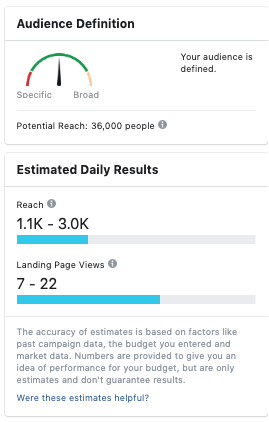
A Quick Guide to Facebook Ad Budgeting
The most common question about Facebook ads that we hear at 9 Clouds is: “How much should I spend on Facebook?”
For businesses that are incorporating Facebook ads into their digital ad strategy for the first time (or re-evaluating for the next quarter or year) deciding on the right ad budget can be difficult and frustrating.
There is no perfect formula for setting the right ad budget, but in our experience, we’ve found that starting out simple is best.
The ideal Facebook ad budget should be based on three things:
- A percentage of your overall digital ad spend
- The size of your intended audience
- The goal of your ad campaigns
In this post, we’ll explain these three basic budgeting principles for your Facebook ads.
(Please note that these principles are simply a good starting point for businesses new to Facebook advertising. You will need to continually monitor and adjust your campaign budgets).
Let’s dig in!
Why Facebook Ads Matter
At 9 Clouds, we talk a lot about Facebook ads and how to create the ideal Facebook ad budget. We have dozens of blog posts explaining how to best use these ads.
It’s for good reason. People spend 30 minutes per day using the Facebook platform, plus about 33 minutes per day on Instagram (also owned by Facebook, or Meta).
In short, Facebook ads matter because they allow you to display the right message to the right audience at the right time.
When targeted to the right people, Facebook ads engage potential customers at their personal stage in the sales funnel — and help guide them toward a purchase.
How Much Should You Spend on Facebook Advertising?
Your Facebook budget should be based on the following three principles.
1. One-Third of Your Entire Digital Ad Budget Should Be Spent on Facebook
Most businesses spend large sums on digital ads, especially pay-per-click ads like Google Ads.
While Google Ads should be an important part of your digital marketing strategy, businesses should realize that advertising on Facebook often costs less than advertising on Google alone.
How can you determine whether your Facebook ads are actually providing you with a good return on investment (ROI)? Facebook actually has a built-in tool called Offline Events that allows you to measure your Facebook ad conversion. Learn more about using Offline Events.
2. Spend $1 / Day for Every 1,000 People in Your Campaign’s Audience
After entering the desired targeting parameters to your ad set, Facebook will project your ad’s potential reach: how many people could potentially see your ad based on the targeting parameters you’ve set.
We can use our “one-third” rule to find our recommended daily ad budget from the example above:
36,000 estimated reach / 1,000 people = $36 / day
If you typically run your ads monthly, over 30 days, this ad will require a lifetime budget of $1,080 ($36 per day x 30 days).
3. Set All Budgets with the Buyer’s Journey in Mind
Not all of your ads will require the same budget.
When your ad strategy follows the buyer’s journey, you’ll reach people at every stage of the sales funnel with a slightly different budget:
- Top of Funnel: Broad message to a larger audience. Requires a larger budget.
- Middle of Funnel: Targeted message to more qualified audience of past customers or those who have been browsing on your website. Requires an average budget.
- Bottom of Funnel: Specific message to an audience of people whom you want to take a specific action. Requires the smallest budget.
Get Better Results from Your Facebook Ad Budget
Setting the right Facebook ad budget isn’t a perfect formula. It often takes some trial and error in order to discover the right budget for your Facebook campaigns and business goals.
From budget setting to targeting to creative format and more, Facebook ads can get complex.
Learn how to make the most of your Facebook ad budget by building quality ads that drive leads and sales with online advertising services from 9 Clouds.
Get More from Your Digital Ads »





